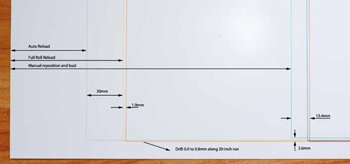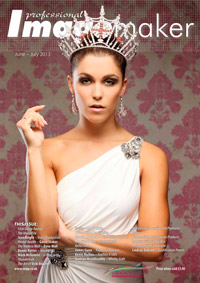articles/Presentation/borders-page3
Imaging without borders! - part 3 of 1 2 3
by Mike McNamee Published 01/06/2013

Generally the print was placed onto the 17-inch width of the roll within 1.8mm side to side (but not better than that). We kept changing the border colour of the 'image' and reprinting to the same area of the roll by winding it back or reloading it completely. The bottom line to this testing is that the print was placed side to side to within this 1.8mm and the runout was between zero and 0.8mm between successive printing attempts.
Move variation was measured in the position of the print upon the page in the direction of printing. This depends upon how the paper is loaded on top of smaller variations print-to-print. Using Auto Roll Reload produces a 30mm difference to loading from scratch (ie removing the roll completely).
If the roll is set manually without taking it right out then the image is placed 150 to 170mm from the Auto Roll position, ie the variation is about 15mm.
In summary then for the 4900 the image was perfectly square in itself with low skew to the edge of the sheet but with a small variation side to side and a large variation front to back depending partly on the method of loading.
We apologise if this has been difficult to follow but there are lots of variations! The conclusion is that the image is usually square in all cases, the roll-fed 4900 is the most accurate on skew, the TPP loaded from the front paper tray is the least accurate and that, in all instances, the only reliable option is to print on a slightly over-sized sheet so that a print may be then adjusted under a window matt. Placing a print snugly into a frame and then expecting it to align with a window matt is not an option!
Please Note:
There is more than one page for this Article.
You are currently on page 3 Contact Mike McNamee
1st Published 01/06/2013
last update 09/12/2022 14:51:51
More Presentation Articles
There are 0 days to get ready for The Society of Photographers Convention and Trade Show at The Novotel London West, Hammersmith ...
which starts on Wednesday 15th January 2025





